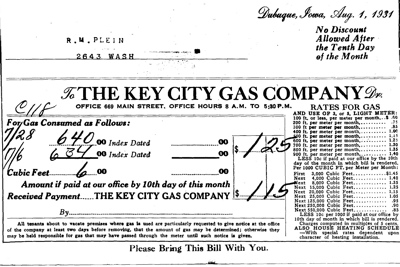Encyclopedia Dubuque
"Encyclopedia Dubuque is the online authority for all things Dubuque, written by the people who know the city best.”
Marshall Cohen—researcher and producer, CNN
Affiliated with the Local History Network of the State Historical Society of Iowa, and the Iowa Museum Association.
KEY CITY GAS COMPANY: Difference between revisions
No edit summary |
No edit summary |
||
| Line 8: | Line 8: | ||
In 1910 the company operated a new plant at 11th and Maple whose specifications were published in the leading engineering journals of the world. One of the unique features of the plant was the world's first reinforced gas "holder" tank. The coke handling department with its facilities for screening was the only one of its kind in the west. (4) | In 1910 the company operated a new plant at 11th and Maple whose specifications were published in the leading engineering journals of the world. One of the unique features of the plant was the world's first reinforced gas "holder" tank. The coke handling department with its facilities for screening was the only one of its kind in the west. (4) | ||
The gas manufactured by the plant was all sold in Dubuque. The byproducts including coke, coal tar and ammonia | The gas manufactured by the plant was all sold in Dubuque. The byproducts including coke, coal tar and ammonia were all sold outside the city. The Dubuque plant manufactured nearly all the ammonia used in the West with the gross tonnage of the new gas station the largest of any point on the [[CHICAGO, MILWAUKEE, AND ST. PAUL RAILROAD]]. (5) | ||
In 1911 the Company had about twelve miles of pipe, 180 city lamps, and furnish lighting facilities to consumers at $3.50 per 1,000 cubic feet. | In 1911 the Company had about twelve miles of pipe, 180 city lamps, and furnish lighting facilities to consumers at $3.50 per 1,000 cubic feet. | ||
Revision as of 18:26, 28 March 2015
KEY CITY GAS COMPANY. The contract for gas lighting with BARKER AND SPILMAN provided that the cost to the city should not exceed $2.50 nor to individuals should not exceed $3.50 per thousand feet. (1) Despite improvements, the company was not profitable. In 1880 Key City Gas assumed the franchise.
By 1904 gas consumption had quadrupled, but the use of tungsten in incandescent light bulbs greatly reduced the use of gas. The gas company continued, however, to grow with the installation of new generating machinery capable of furnishing 3,500 horsepower. No other company in the city had half that power capacity. (2) The company showed a definite interest in Dubuque. Orders for supplies were placed whenever possible with Dubuque companies and Dubuque labor was employed. Gangs of workers spent the entire summer laying gas mains, the leading being twenty-inches in diameter. These were advertised as "the largest in Iowa" and the "deepest in the northwest." (3)
In 1910 the company operated a new plant at 11th and Maple whose specifications were published in the leading engineering journals of the world. One of the unique features of the plant was the world's first reinforced gas "holder" tank. The coke handling department with its facilities for screening was the only one of its kind in the west. (4)
The gas manufactured by the plant was all sold in Dubuque. The byproducts including coke, coal tar and ammonia were all sold outside the city. The Dubuque plant manufactured nearly all the ammonia used in the West with the gross tonnage of the new gas station the largest of any point on the CHICAGO, MILWAUKEE, AND ST. PAUL RAILROAD. (5)
In 1911 the Company had about twelve miles of pipe, 180 city lamps, and furnish lighting facilities to consumers at $3.50 per 1,000 cubic feet.
By the 1920s the Key City Gas Company was the largest coal gas plant in Iowa. In 1927-28 the gas plant, constructed about thirty years before, was remodeled for a quarter of a million dollars. (6) The additions included fifteen vertical coke ovens installed by the United Gas Improvement Company of Philadelphia. Of German invention, these ovens were the first of their kind constructed in the United States. A color film of the proposed Dubuque installation was a popular feature of the convention of gas engineers in Chicago that year. (7)
The 1868-69 Dubuque City Directory listed the northwest corner of Dodge and Bluff with the office at 104 1/2 Main.
The 1899-1900 Dubuque City Directory listed 669 Main.
The 1913 Dubuque and Dubuque County Directory through the 1929 Dubuque City Directory listed the address as 669-79 Main.
---
Source:
1. Oldt, Franklin T., History of Dubuque County Iowa . Chicago: Goodspeed Historical Association, 1880. http://www.ebooksread.com/authors-eng/franklin-t-oldt/history-of-dubuque-county-iowa-being-a-general-survey-of-dubuque-county-histor-tdl/page-11-history-of-dubuque-county-iowa-being-a-general-survey-of-dubuque-county-histor-tdl.shtml
2. "Gas Introduced to Dubuquers Just One Hundred Years Ago," Telegraph Herald, Oct. 24, 1954, p. 20
3. Ibid.
4. "Key City Gas Works are Unexcelled in Matter of Completeness in the World," Telegraph-Herald, February 22, 1910, p. 1
5. Ibid.
6. "Gas Introduced..."
7. Ibid.





